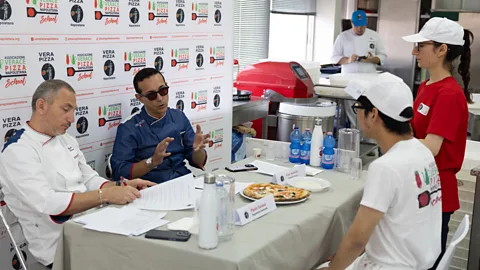Italy: Undercover pizza detectives

Rome: As pizza’s popularity spreads around the world, a group of top-secret agents are travelling the globe on espionage missions to determine what “real” pizza is.
On a sweltering day bleached by the fearsome southern Italian sun, a group of international travellers have gathered a stone’s throw from Naples’ San Gennaro catacombs, named for the city’s patron saint.
But these visitors aren’t here to venerate the ancient martyr; they’ve come in service of something equally important to the city’s identity. Hailing from Belgium, France, Japan, South Korea, Canada and Brazil, these men and women are all aspiring pizzaioli (traditional Italian pizza makers), and they are about to take the biggest pizza test of their lives.
The trainees are at the headquarters of the Associazione Verace Pizza Napoletana (the “True Neapolitan Pizza Association”, or AVPN for short). Founded in 1984, this organisation exists to “promote and protect” an exacting vision of the city’s most famous culinary marvel, and was instrumental in inscribing “the art” of Neapolitan pizza-making as a Unesco Intangible Culture Heritage of Humanity several years ago.
From its humble origins as a Neapolitan street food in the late 1800s pizza has become one of the world’s most beloved, ubiquitous dishes. Though there are two traditional types of Neapolitan pizza (the Margherita, topped with tomato sauce, mozzarella and fresh basil; and the marinara, which uses oregano and garlic instead of basil and doesn’t contain cheese) myriad contemporary varieties have popped up worldwide in recent decades – from slices dressed with blue cheese and honey to the creamy, lemon peel-topped Crisommola del Vesuvio by chef Franco Pepe.
But just as there are strict criteria for determining “authentic” Champagne or Parmigiano cheese, this group of culinary custodians has set out to ensure that the delectable dish stays true to its Neapolitan roots – at least if you’re going to call it “real” pizza.
“There is a big connection between this kind of food and the soul of Naples,” says Massimo Di Porzio, vice president at the AVPN, who is flecked with flour in his corporate profile photo.
With its training school, competitions, trade fairs and a large bronze pizza statue shining just outside its headquarters the AVPN has become a veritable empire of pizza authenticity. Its lengthy guidelines dictate that all certified pies must consist of a “roundish seasoned disc” with a high-border, puffy crust (cornicione) no taller than 1-2cm. There should be no “big bubbles” or “burned spots”. Pizzas must be “soft”, “elastic” and foldable. Pizza-makers can’t use a rolling pin or baking tray. Cooking a pizza for longer than 90 seconds is sacrilegious. And the final product must be consumed within 10 minutes after emerging from the oven.
On the blistering-hot final day of the AVPN’s rigorous monthly training course, the international students will put their newfound pizza knowledge to the test. Attendees have studied dough-leavening techniques and hydration, the ins and outs of yeast, the nuances of picking fresh toppings and ideal salt-to-water ratios. They’ve practiced the intricacies of placing pizza into ovens – a simple-seeming but deceptively tricky step – all with the goal of baking a consistently perfect pie.
“I was quite nervous, especially as people started coming back from their exams,” says Gemma Eldridge, a Canadian pizza-maker. “But you’re really only there for three minutes. You don’t really have time to be nervous.”
From 10:00 to 18:00 during the nine-day course, Eldridge and her fellow pizzaioli baked as many as 40 practice pies each day. Today, students pick at their rehearsal Margheritas as they await the return of the other trainees from their exams, under the scrutiny of local pizza celebrities Gino Sorbillo and Paolo Surace.
The chefs are being judged on an undisputed classic: the Margherita. While the pizzaioli refine their technical know-how through this intensive programme, the course is only their first step towards pizza mastery. The real work begins with maintaining these standards in pizzerias back home – an ongoing test that will continue throughout the rest of their careers, should they one day work in accredited Neapolitan pizza restaurants.
While pizza-chef training is available to anyone, the bar is higher for restaurants to get accredited. Pizzerias must first employ an AVPN-trained pizzaiolo. They then have to fill out reams of forms in which they swear to “accept, respect and promote the tradition of the Neapolitan pizza”. They must photograph their kitchen, equipment and ingredients, as well as take videos of their head pizza chef preparing dough and making and cooking a pizza. This is all sent off to the AVPN headquarters in Naples with no guarantee of approval.
To date, roughly 1,000 pizzerias from Japan to Siberia and Ecuador to the UK have signed up to be part of this elite pizza club and, once accredited, can display their AVPN certificate bearing a striped figure wielding a baking peel, all together forming a global network of pizzerias where travellers know they can get the real deal.
Still, a restaurant’s scrutiny isn’t over once it’s accredited, as the AVPN intermittently dispatches secret pizza agents on espionage missions to clandestinely spy on the restaurants. Any pizzeria found non-compliant with the group’s standards by these quality-control spies risks de-listing.
According to one such agent, who cannot be named: “The most serious error I found was a pizza that was crispy and with dough that was definitely not approved.” The Association verified the problem and then promptly removed this restaurant from its list of pizzerias.
In Japan, a pizzeria that was kicked out of the organisation – but continued to display its certificate – learned of the consequences the hard way. “We went to Osaka and removed it,” laughs Di Porzio, recalling the lawyer accompanying the pizza enforcers.
This mission to define authentic pizza has a curious side effect, says Karima Mover-Nocchi, a food historian at the University of Siena, who suggests the whole process is as much about myth-making as it is maintaining traditional standards.
By codifying “authentic” pizza, she says the AVPN creates an “inner circle” of true-pizza certificate holders. In short: all the exclusivity gets people salivating over pizza more.
“The AVPN aren’t just preserving a tradition, they’re producing it,” she says. “[The AVPN is elevating pizza] into a transcendental experience. They’re safeguarding the dish, but also creating a mystique – and you’re made to feel like you’re part of something that’s enduring.”
Still, given the high drama of these top-secret cloak-and-dagger pizza investigations, it’s ironic that such fussy standards to maintain “traditional” Neapolitan pies haven’t always existed.
According to Di Porzio, centuries ago, Naples’ artisanal pizza-makers each had differing techniques, usually passed down from father to son. But in the late 20th Century, faced with a groundswell of shoddy fast-food simulacra that offered fake-Neapolitan pizza, AVPN founder Antonio Pace – who is from a long lineage of pizzaioli – gathered 16 other pizza-making families to standardise what makes an “authentic” pie.
There were bumps along the way for the “17 families”, as they are known. A major row erupted over the finer details of dough fermentation, but the initial guidelines were published in 1984 and the AVPN was formed.
In 1998, the organisation teamed up with the nearby Università Parthenope di Napoli to study pizza science, cutting-edge baking technology and the broader impact of the food, co-creating the Socio-Economic Observatory of Neapolitan Pizza. A yearly conference of top pizza-makers debate whether new findings, such as improvements to flour manufacturing, necessitate a rejigging of the regulations.
But for all this precision and protectiveness over pizza napoletana, Antonio Puzzi, the editor-in-chief of the magazine Pizza e Pasta Italiana, notes that Italy has dozens of different types of pizzas.
There’s Neapolitan pizza fritta(deep-fried calzone), but also Roman pizza, which is crispier and crunchier than the Neapolitan style and rolled with a pin rather than hand-stretched. Then there’s pizza nel ruoto (pizza baked in a pan), cooked in a small baking tin; the hot and crispy deep-fried pizzonta from Abruzzo; and a long list of variations on focaccias and flatbreads.
“There are a lot of recognised kinds of pizza in many cities and many states,” says Puzzi. “But the only official representation is for Neapolitan pizza.”
Even with Italy’s many pizza varieties, certain faux pas – such as ordering a chicken pizza overseas – remain just as likely to invoke the wrath of Italian purists. Case in point: after trying in vain to open 880 shops in Italy, US pizza brand Domino’s famously filed for bankruptcy in the bel paese in 2022 – and never dared to open a branch in Naples.
Yet, some argue that Italian tastes arechanging, and despite the AVPN’s seeming rigidity, they now seem to be more amenable to modifying their exacting standards than they were in the past. “If we can improve something, we’ll change it, so we are very open,” says Di Porzio.
In 2024, Sorbillo, one of the AVPN’s examiners and accredited restaurateurs, controversially debuted a Neapolitan pizza with Hawaiian-style toppings. While critics such as Puzzi describe the pizza as a “provocation” – and employees of the eponymous Naples restaurant Gino e Toto Sorbillo all but refused to serve it to me – Sorbillo believes there’s room for both modernity and tradition.
“Pizza does not stop at a certain point – it’s always developing, changing, cooperating with the Association, there is always something to learn,” he says. “The pizza of today is not the same as 40 years ago.”
Yet times do change, acknowledges Di Porzio, who says the AVPN faced a “lot of criticism” for accepting in 2013 that Neapolitan pizza could be cooked in electric ovens as well as the traditional wooden receptacles. The decision rankled the most hardcore traditionalists, says Di Porzio.
Still, even as trends and styles shift and previously taboo toppings become de rigueur, Di Porzio and the AVPN believe it’s important to maintain traditional cooking methods too.
“I always say, pizza napoletana is not necessarily the best, but the pizza that has its strongest roots in the culture,” says Di Porzio. “So it’s a skill that we need to teach and preserve.”





